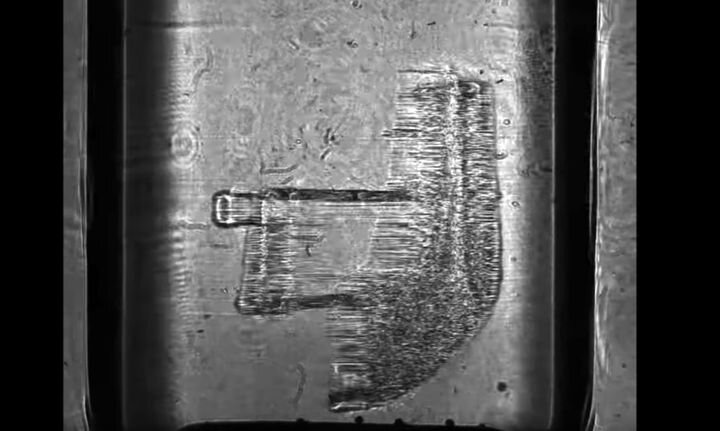![View of Readily3D’s volumetric 3D printer, with illuminated build chamber in the center [Source: Readily3D]](https://fabbaloo.com/wp-content/uploads/2020/05/image-asset_img_5eb0509db1d35.jpg)
Researchers from EPFL showed a new volumetric 3D printing process, but I have questions.
Volumetric 3D printing is something that’s been recently discussed, mostly in research circles. It’s a form of 3D printing that is unlike all current methods, each of which either produce objects a layer at a time, or deposit material, voxel by voxel. Instead, volumetric 3D printing attempts to 3D print the entire object simultaneously – all layers at once, so to speak.
I first heard of this approach about a year ago with the announcement of “Computed Axial Lithography” by researchers at Berkeley. This method attempted to perform the reverse of a CAT scan, in which images of a subject are taken from multiple angles and subsequently merged into a 3D model. Instead, CAL takes a 3D model and produces the images, which are then projected into a liquid photopolymer where the original 3D shape solidifies. It’s a very rapid process, dramatically faster than current resin 3D printing processes.
The concept was taken a bit farther by 3D printing pioneer Adrian Bowyer in his recent proposal for “Electric 3D Printing”, in which this “Reverse CT-Scan” approach is combined with two other materials science developments into a potentially powerful 3D printing process. As far as we know, Bowyer is still developing this process.
Readily3D 3D Printing Process
Now we hear that researchers from EPFL have developed yet another volumetric process, and they’re attempting to commercialize it through a new company called “Readily3D”. They say:
“In our volumetric 3D printer, a liquid photo-sensitive polymer is irradiated from multiple angles with pre-computed dynamic light patterns. The three-dimensional accumulation of light dose inside the build volume results in the solidification of the desired object in a matter of seconds.”
This appears to be quite similar to the previous projects mentioned above: simultaneous and rapid 3D printing using projections from multiple directions.
There’s not a lot more about Readily3D’s project, aside from a short video from EPFL:
Based on what I’ve seen here, I have a couple of questions.
First, I don’t understand how thick objects are made. Imagine “growing” a solid sphere with this volumetric method. As the surface of the sphere begins to form, does it not block the transmission of light to the interior portions? Would you end up with a kind of “egg” print with a soft interior that’s only partially solidified?
I suppose this could be overcome with some tricky software that initially projects “stronger” images of interior portions before later strengthening the exterior imaging. But then we’re building the object from inside to outside and not simultaneously all the way through. I’d be very interested to know how Readily3D handles this challenge.
![A 3DBenchy being formed within the rotating Readily3D build chamber [Source: Readily3D]](https://fabbaloo.com/wp-content/uploads/2020/05/image-asset_img_5eb0509e0b7d4.jpg)
The second question I have relates to how the light is applied, and what effects it may have. As you can clearly see in their video, the build volume — a small clear cylinder of liquid photopolymer — is being slowly rotated, while presumably the surrounding apparatus blinks out the appropriate light images. This means that the fluid in the build chamber is rotating during 3D printing.
This is quite different from the CAL process mentioned above, where the build chamber is static and the light engine is what rotates around the photopolymer. In CAL, the liquid is static, and this could be an advantage. One of the CAL researchers said, in our previous post:
“As the object is not moving relative to the liquid during printing, it is not limited by fluid flow, which means that we are able to use CAL to print into materials that have a higher viscosity, broadening the range of material properties that can be accessed. By avoiding fluid flow during printing, we can even print into very soft and delicate materials, like the gelatin methacrylate, which may open new applications in bioprinting of soft tissues.”
It could be there are some limitations to Readily3D’s approach. But this is not surprising; every 3D printing process has limitations of one sort or another; it’s just that the vendors tend to not explain that to you for some reason.
Despite my questions, I’m quite encouraged by the developments in volumetric 3D printing, as it is perhaps the only currently feasible approach to overcome the truly outrageous print durations we’re all subjected to when using today’s 3D printing technology. Why, I just started ANOTHER 21 hour print job myself. That’s a long time, and I’d much rather have it done in seconds.
Via Readily3D

